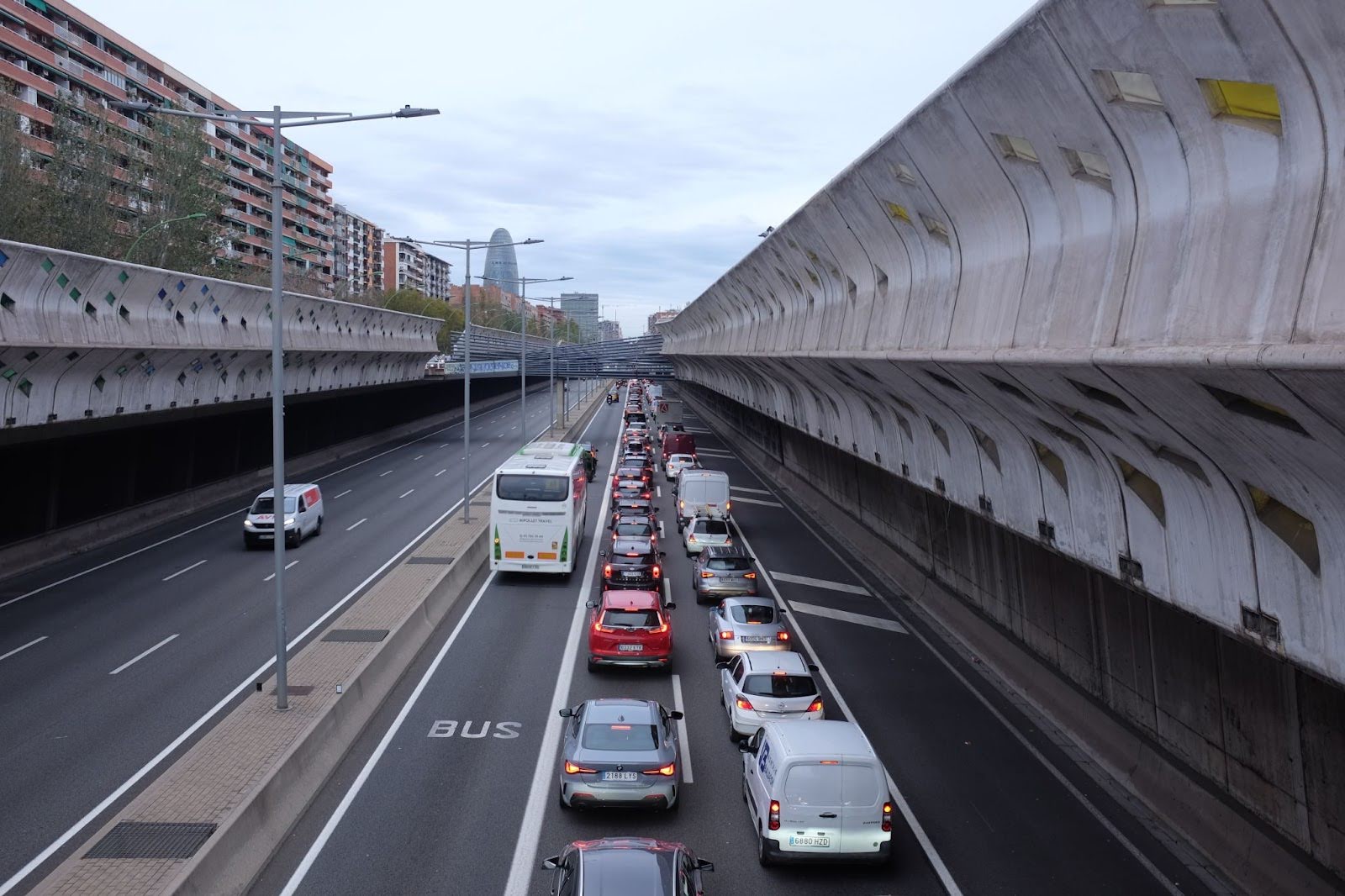
Commuting Challenges: spot light on Barcelona
Barcelona doesn’t always look so beautiful, especially not during rush hour. This is Gran Vía, one of the major thoroughfares in the city, at around 8 am on a Monday. I count around 40 cars in this picture, all moving at a snail’s pace as they pollute their way into the big city. Let’s be generous, and say each car carries an average of 1.5 passengers. That’s a grand total of 60 people. Do you know how many full-size single-deck buses it would take to carry all those people? One. And that’s with room to spare.
Now, before everyone starts to think badly of Barcelona’s public transport options, I hasten to add that there are a remarkable 900 buses active during the morning rush hour in Barcelona, and incredible improvements have been made to infrastructure in the city in the past years (note the left lane reserved for buses in the photo). Crucially though, those buses run within the city.
Mobility Gap in Rural Areas
For people who live outside the city and commute in, that’s where it gets more complicated. The most common way to get to work for Spaniards is by private vehicle, with 63% travelling by car. Before we blame the individual, what are the public transport conditions like outside of big cities? Are commuters able to access adequate public transport options to be sure that they will arrive at work, school or university on time? Unsurprisingly, not really.
Rural areas in Spain suffer from a significant mobility gap, in comparison to urban areas. Low passenger numbers can make it difficult to fund public transport options, and micro-mobility options seen in cities (such as rentable bicycles) are non-existent. As a result, Car is King.
Adapting Solutions for Rural Transport
To get people out of private vehicles, accessible alternatives have to be made available. Providing adequate transport options in rural areas is not a question of copy-pasting the solutions used in cities. Whilst electric scooters and fix-line buses might be optimal in urban areas, rural transport services need to be more adaptable.
To truly meet the needs of all citizens, public transport should be seen as a dynamic ecosystem offering multiple options based on the scenario in question.
Nemi’s Innovative Approach
This is just what we’re working on here at Nemi: we aim to provide accessible, flexible and reliable bus services, with a particular focus on rural areas. Our on-demand transport system enables people to reserve a seat on the bus, and then the driver will only stop at places that have been previously requested. The beauty of this system is that there can be many more potential stops (see our stop ‘cloud’ below). Passengers can be dropped off at a train or bus station to continue their onward journey. There’s no need to stand around waiting for the bus; with our app, you can see exactly when the bus is going to arrive, and when you will arrive at your destination. As a result, more people in previously under-served areas can access crucial services, and access work or education without a private vehicle.
As well as being a good fit for users, our demand-responsive solution is a cost-effective way of providing public transport options: drivers can take the most efficient route possible to only pick up passengers who have reserved ahead of time, leading to cost savings.
Corporate Solutions for Commuting
On-demand transportation also presents an innovative solution for ferrying employees directly to their workplaces. In 2020, Nemi spearheaded the COMMINSAFE pilot, providing an on-demand bus service to commuters who work in areas underserved by public transport options. By hiring a dedicated bus service that picks up employees from strategically located stops near their homes and drops them directly at the office, the company transforms the daily commute into a streamlined and stress-free experience. Beyond contributing to the development of sustainable mobility solutions, company benefits of this sort can play a pivotal role in improving employee satisfaction levels and enhancing the company’s ability to attract and retain top-tier talent.
Towards a Comprehensive Mobility Ecosystem
In the ever-evolving landscape of transport solutions, on-demand responsive transport has emerged as a pivotal component within the complex mobility ecosystem. The next time you see a queue of cars stretching for miles, think about whether the people in those cars can access a suitable public transport alternative. The answer for now may very well be no, but it doesn’t have to be that way. Comprehensive and accessible mobility for all is within reach; it’s a matter of embracing innovation and channelling resources toward a future where public transport truly serves everyone.




